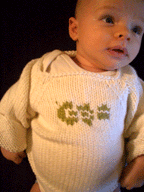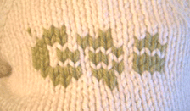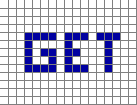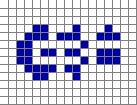
« PREVIOUS ENTRY
Should students be banned from using laptops in class?
NEXT ENTRY »
Cockroaches make group decisions

As a principle around here, I tend to avoid posting about my private life. But here’s something that is simply too cool not to share: Debbie Chachra, a longtime Collision Detection reader, knitted an utterly awesome sweater for my baby Gabriel — and the pattern is derived from John Conway’s cellular-automata Game of Life. Here’s a close-up of that pattern on the chest:

The sweater came into being during the December holidays. I had brunch with Debbie — an engineering professor at Olin College — and she offered to knit a sweater for my then-impending baby. We discussed what design to put on the chest, and I quickly began dreaming up variously unendurably geeky options: A famous mathematical equation? A pixellated video game icon from the 80s?
Then I remembered that, of course, knitting and weaving take place in a grid-like lattice, which is why the first robot industrial machines were the automated looms — and, indeed, why we owe some of our earliest concepts of computing to those looms. And then I remembered Conway’s Game of Life, in which you place a set of markers down on a grid, and let them “grow” according to a simple set of rules. The Game of Life is famous for producing unpredictable results from very simple original patterns: Start by laying down maybe 7 or 8 markers, and within a handful of generations you’ll be staring at a massive blooming organism of Rorschachian beauty.
The Game of Life has quite a lot of nostalgic resonance for me. Back when I was a kid, I found a BASIC version of the Game of Life from a computer magazine, and a friend and I spent a weekend programming it into his Atari computer. It took us forever to debug our typing mistakes, and we finally got it running at some ungodly hour late at night. It promptly blew my tiny brain, particularly when I discovered the many peculiar organisms in the Conway universe — such as the Flyer, a small five-cell pattern that slowly replicates itself diagonally, inching eternally off into the infinite Euclidean freespace of the grid.
Simple beginnings; emergent complexity; pretty designs: This all began to look like a fine concept for my baby’s sweater. But what to use as the initial pattern? I messed around with a number of ideas, and produced a set of big, lovely amoeba-like patterns. But my favorite came when I experimentally drew my son’s initials — GET — on a grid and ran the automata program for a single generation. The initials looked like this …

And the first-generation result looked like this …

It’s almost a reverse-image of the letters, except not quite. Actually, it looks as if his name were spelled in some language reverse-engineered from a crashed alien/human clone-hybrid UFO. Debbie did a meticulous job with the lettering, and used this gossamer-soft wool, so the baby loves wearing it. It’s just a lovely, lovely piece of work!
(Many, many thanks to Debbie Chachra for this one!)
I'm Clive Thompson, the author of Smarter Than You Think: How Technology is Changing Our Minds for the Better (Penguin Press). You can order the book now at Amazon, Barnes and Noble, Powells, Indiebound, or through your local bookstore! I'm also a contributing writer for the New York Times Magazine and a columnist for Wired magazine. Email is here or ping me via the antiquated form of AOL IM (pomeranian99).

ECHO
Erik Weissengruber
Vespaboy
Terri Senft
Tom Igoe
El Rey Del Art
Morgan Noel
Maura Johnston
Cori Eckert
Heather Gold
Andrew Hearst
Chris Allbritton
Bret Dawson
Michele Tepper
Sharyn November
Gail Jaitin
Barnaby Marshall
Frankly, I'd Rather Not
The Shifted Librarian
Ryan Bigge
Nick Denton
Howard Sherman's Nuggets
Serial Deviant
Ellen McDermott
Jeff Liu
Marc Kelsey
Chris Shieh
Iron Monkey
Diversions
Rob Toole
Donut Rock City
Ross Judson
Idle Words
J-Walk Blog
The Antic Muse
Tribblescape
Little Things
Jeff Heer
Abstract Dynamics
Snark Market
Plastic Bag
Sensory Impact
Incoming Signals
MemeFirst
MemoryCard
Majikthise
Ludonauts
Boing Boing
Slashdot
Atrios
Smart Mobs
Plastic
Ludology.org
The Feature
Gizmodo
game girl
Mindjack
Techdirt Wireless News
Corante Gaming blog
Corante Social Software blog
ECHO
SciTech Daily
Arts and Letters Daily
Textually.org
BlogPulse
Robots.net
Alan Reiter's Wireless Data Weblog
Brad DeLong
Viral Marketing Blog
Gameblogs
Slashdot Games